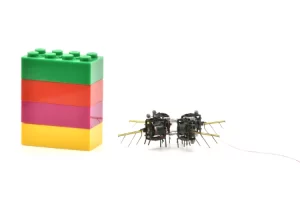With bee populations declining at an alarming fee, scientists are racing to seek out options earlier than world agriculture suffers irreversible penalties. MIT researchers have been exploring methods to imitate nature’s best pollinators, and in early 2025, they launched a serious breakthrough: ultra-light robotic bees able to flying 100 occasions longer than earlier prototypes.
The brand new prototype can carry out advanced aerial stunts, together with double aerial flips.
Even essentially the most superior bug-sized robots have struggled to match the endurance, velocity, and maneuverability of actual pollinators. Now, by finding out the anatomy of bees, MIT researchers have utterly overhauled earlier designs.

The newest model can hover for about 1,000 second”greater than 16 minute ”in comparison with just some seconds in earlier fashions. Weighing lower than a paperclip, the robotic may also fly considerably quicker (35 centimeters per second) and do a physique roll and double aerial flips.
The enhancements stem from a serious redesign aimed toward rising each flight precision and sturdiness.
The robotic’s wings transfer utilizing synthetic muscle mass, which work like tiny, versatile engines. These muscle mass are made by stacking layers of soppy materials (elastomer) between two super-thin carbon nanotube electrodes and rolling them right into a tender cylinder. When electrical energy flows by, the muscle mass shortly squeeze and stretch, creating the pressure wanted to flap the wings.
In older designs, these muscle mass had bother dealing with the high-speed actions required for flight. They’d begin bending in methods they shouldn’t, making the robotic weaker and fewer environment friendly.
The brand new design features a particular system that stops this undesirable bending, lowering pressure on the muscle mass and permitting them to generate extra energy for flying.
Moreover, the refined construction leaves sufficient area to combine tiny batteries or sensors, which may ultimately allow the robotic to function autonomously outdoors of managed environments.
These developments convey MIT’s robotic bees nearer to real-world deployment, the place they may play an important position in agricultural pollination.
The potential influence of robotic pollinators is tough to disregard. In areas the place pure pollinators have disappeared, they may assist keep crop manufacturing and meals safety.
In contrast to actual bees, they are not susceptible to illness, local weather change, or habitat destruction. Farmers may even program them for focused pollination, optimizing yields for particular crops.
But, regardless of their benefits, robotic bees elevate vital questions.
The excessive value of robotic bees might restrict their accessibility for small-scale farmers. And whereas they could quickly offset the lack of pure pollinators, they do nothing to revive ecological stability.
Bees help total ecosystems, contributing far past pollination alone. Some specialists warn that an overreliance on synthetic pollinators may divert consideration from conservation efforts, slowing down essential work to rebuild pure bee populations.
Sources






